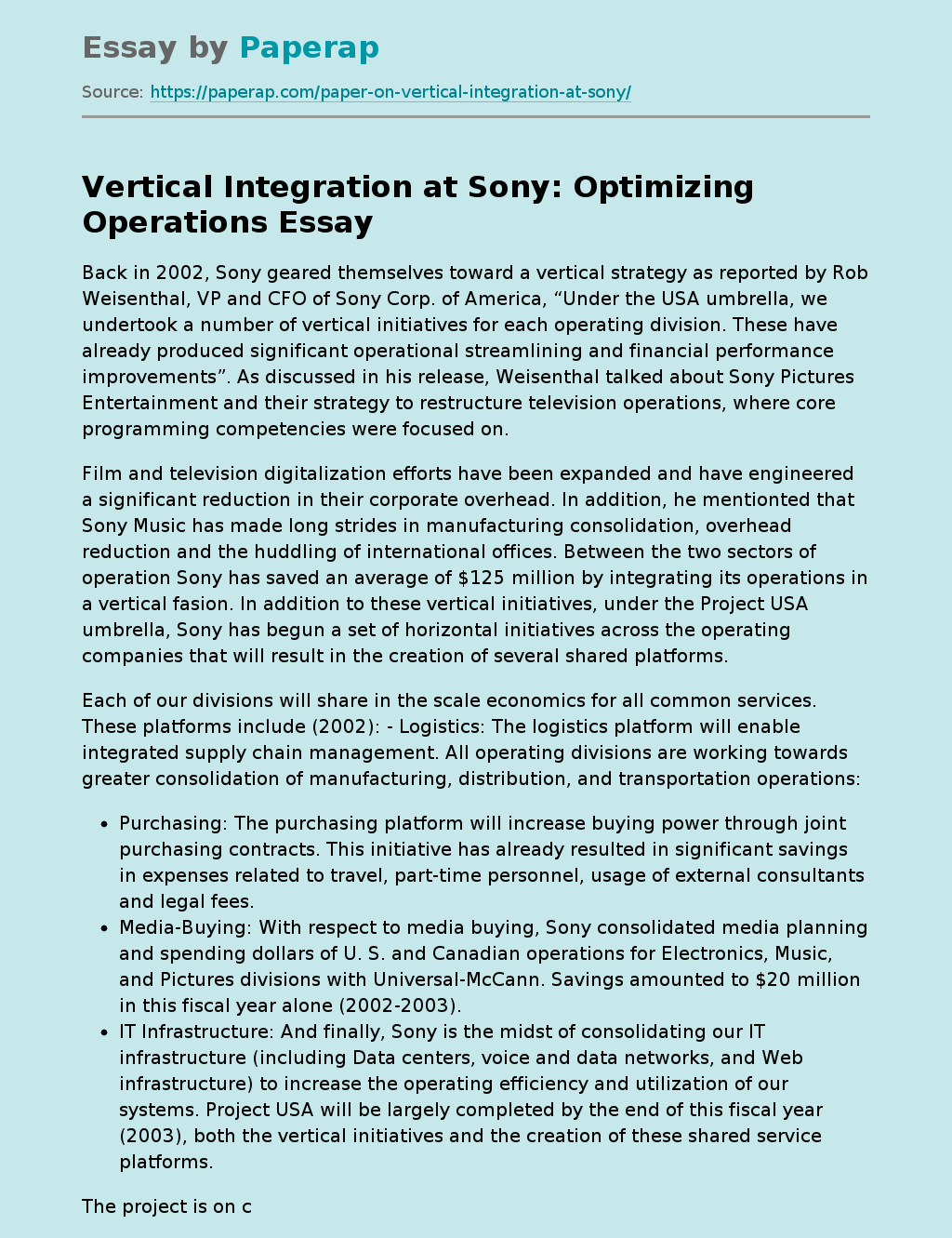Vertical Integration at Sony: Optimizing Operations
Back in 2002, Sony geared themselves toward a vertical strategy as reported by Rob Weisenthal, VP and CFO of Sony Corp. of America, “Under the USA umbrella, we undertook a number of vertical initiatives for each operating division. These have already produced significant operational streamlining and financial performance improvements”. As discussed in his release, Weisenthal talked about Sony Pictures Entertainment and their strategy to restructure television operations, where core programming competencies were focused on.
Film and television digitalization efforts have been expanded and have engineered a significant reduction in their corporate overhead.
In addition, he mentionted that Sony Music has made long strides in manufacturing consolidation, overhead reduction and the huddling of international offices. Between the two sectors of operation Sony has saved an average of $125 million by integrating its operations in a vertical fasion. In addition to these vertical initiatives, under the Project USA umbrella, Sony has begun a set of horizontal initiatives across the operating companies that will result in the creation of several shared platforms.
Each of our divisions will share in the scale economics for all common services. These platforms include (2002): – Logistics: The logistics platform will enable integrated supply chain management. All operating divisions are working towards greater consolidation of manufacturing, distribution, and transportation operations:
- Purchasing: The purchasing platform will increase buying power through joint purchasing contracts. This initiative has already resulted in significant savings in expenses related to travel, part-time personnel, usage of external consultants and legal fees.
- Media-Buying: With respect to media buying, Sony consolidated media planning and spending dollars of U.
S. and Canadian operations for Electronics, Music, and Pictures divisions with Universal-McCann. Savings amounted to $20 million in this fiscal year alone (2002-2003).
- IT Infrastructure: And finally, Sony is the midst of consolidating our IT infrastructure (including Data centers, voice and data networks, and Web infrastructure) to increase the operating efficiency and utilization of our systems. Project USA will be largely completed by the end of this fiscal year (2003), both the vertical initiatives and the creation of these shared service platforms.
The project is on course to lead us to meaningful margin enhancement and increased operating efficiencies across our divisions. Overall, we anticipate over $400 million of annualized savings from the overall project including the initiatives at Electronics. We began generating savings this past fiscal year and it will take three years for the full impact to kick in, Weisenthal reported.
Surprisingly, after extensive research it was found that, more currently, Sony is taking small steps to flatten out their supply chain with a horizontally integrating strategy. According to an article titled, Sony’s semi biz to pivot from vertical to horizontal, written by Yoshiko Hara at Electronics Supply & Manufacturing, Sony Corporation is steering its semiconductor business from vertically integrated operation to fab-lite operation that would involve outsourcing production of the Cell processor. This move is a significant turnaround from Sony’s previous strategy to develop and manufacture core chips internally. “We’ll invest in semiconductors on an asset-lite policy, which puts much weight on the investment efficiency” said Yutaka Nakagawa, executive deputy president of Sony in charge of the semiconductor business. “We’ll focus more on the competitive areas”. It seems that this tactical approach is meant for the short run, and lacks the vision needed for long term sustainability.
Sony used to plan, design, manufacture and implement processors in its own game machines, including the PlayStation line; Sony used to have great success with its game processors due to its vertical structure but now the future is uncertain. Future Vertical Integration According to the article, Sony’s semi biz to pivot from vertical to horizontal, Sony plans to keep its research and development teams running strong, but will outsource key manufacturing processes. Even if outsourced, game processors will continue to be one of Sony’s main semiconductor products.
The company intends to boost all the investment on Cell processor from the game business. Sony has invested a total of 460 billion yen (about $3. 8 billion) on semiconductors over a three-year period. Of this amount, 200 billion yen ($1. 7 billion) was spent on the Cell processor. In the coming three-year “mid-term” period beginning next April, “We are considering decreasing investment in semiconductors greatly,” Nakagawa said. Under the new policy, Sony intends to focus on three areas—imagers, game LSIs and system-on-chip LSIs for audio/video devices.
Sony has about 60 percent market share in the imager market and is now reinforcing CMOS sensors as well. One hundred and fifty engineers were shifted to the imager section from audio/video sections to boost development. In the audio/video area, system-on-chip LSIs for TVs and Blu-ray Disc next-generation DVD products will be reinforced, but non-profitable chips such as GPS-integrated chips will be discontinued. Sony’s semiconductor sales are expected to increase by 57 percent from 490 billion yen ($4. 1 billion) to 770 billion yen ($6. billion) next fiscal year, ending March, owing to the demand from game consoles and sales of imagers. About 70 percent of its sales are for its own products and 30 percent of the sales come from the merchant market. Sony’s semiconductor business had been losing money before turning to the black (positive) in the October through December period of 2007. Nakagawa intends to keep the business in the black and moving forward while providing the highest levels of quality products and customer service.
Vertical Integration at Sony: Optimizing Operations. (2017, Dec 29). Retrieved from https://paperap.com/paper-on-vertical-integration-at-sony/

